尚硅谷springboot3核心特性-核心原理(五)
事件和监听
生命周期监听
场景:监听应用的生命周期
监听器-SpringApplicationRunListener
- 自定义
SpringApplicationRunListener来监听事件;- 编写
SpringApplicationRunListener实现类 - 在
META-INF/spring.factories中配置org.springframework.boot.SpringApplicationRunListener=自己的Listener,还可以指定一个有参构造器,接受两个参数(SpringApplication application,String[] args) - springboot在
spring-boot.jar中配置了默认的Listener,如下1
2
3//EventPublishingRunListener用来做事件监听
org.springframework.boot.SpringApplicationRunListener=\
org.springframework.boot.context.event.EventPublishingRunListener
- 编写
Listener先要从META-INF/spring.factories文件中读到
| 类型 | 方法名 | 描述 |
|---|---|---|
| 引导: 利用BootstrapContext引导整个项目启动 |
starting | 应用开始,SpringApplication的run方法一调用,只要有了BootstrapContext就执行 |
| environmentPrepared | 环境准备好(把启动参数等绑定到环境变量中,但是ioc还没有创建) | |
| 启动 | contextPrepared | ioc容器创建并准备好,但是source(主配置类)没有加载。并关闭引导上下文;组件都没有创建 |
| contextLoaded | ioc容器加载,主配置类加载进去了,但是ioc容器还没刷新(我们的bean没创建) | |
| ====截至以上,ioc容器里面还没创建bean呢==== | ||
| started | ioc容器刷新了(所有bean造好了),但是 runner 没有调用 | |
| ready | ioc容器刷新了(所有bean造好了),所有 runner 调用完了 | |
| 运行 | 以上步骤都正确执行了,代表容器 running | |
| 失败 | failed | 成功启动并不会执行该方法,started之前如果异常了会直接执行该方法,如果没有异常执行ready,ready异常了也会执行该方法 |
生命周期全流程
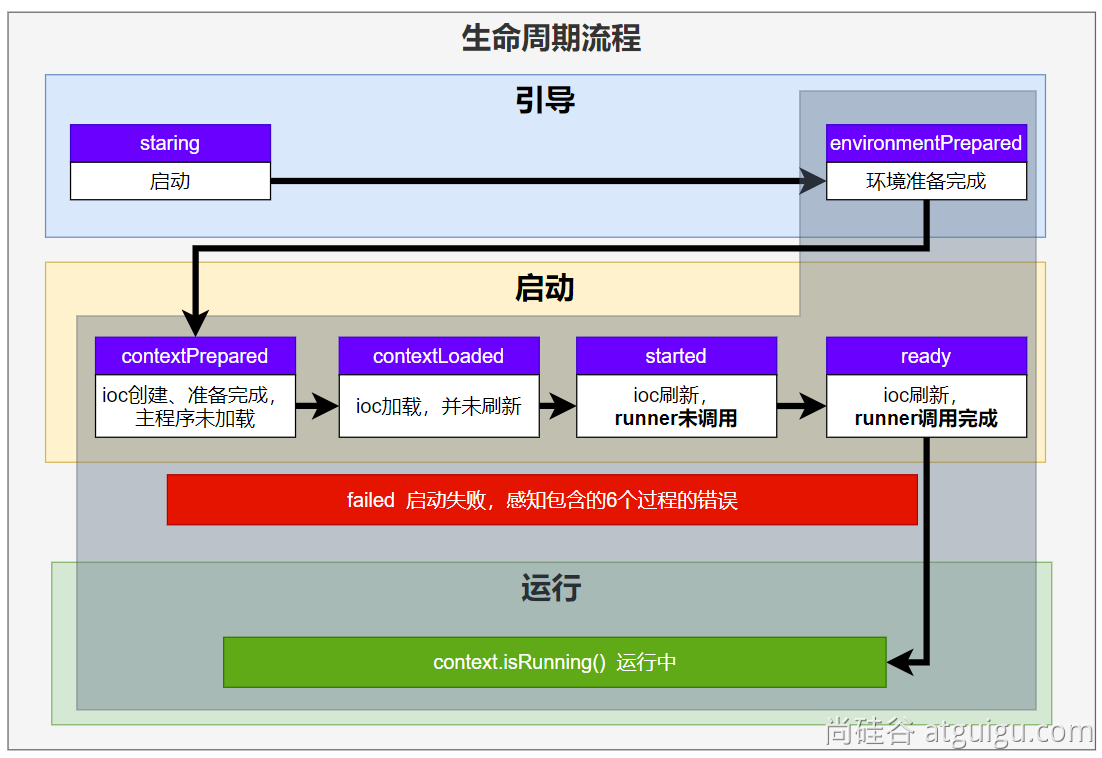
事件触发时机
各种回调监听器
BootstrapRegistryInitializer:感知特定阶段:感知引导初始化META-INF/spring.factories- 创建引导上下文
BootstrapContext的时候触发 application.addBootstrapRegistryInitializer()- 场景:项目启动进行密钥对授权。
ApplicationContextInitializer:感知特定阶段:感知ioc容器初始化META-INF/spring.factoriesapplication.addInitializers()
ApplicationListener:感知全阶段:基于事件机制,感知事件,一旦到了哪个阶段可以做别的事情@Bean或@EventListener:事件驱动application.addListeners()或SpringApplicationBuilder().listeners()META-INF/spring.factoriesApplicationListener可以监听springboot提供的事件,也可以监听自定义事件,监听自定义事件可以使用@Bean或@EventListener方式配置,监听springboot提供的事件需要使用META-INF/spring.factories方式配置
SpringApplicationRunListener:感知全阶段生命周期+各种阶段都能自定义操作;功能更完善META-INF/spring.factories
ApplicationRunner:感知特定阶段:感知应用就绪ready,卡死应用,就不会就绪@Bean
CommandLineRunner:感知特定阶段:感知应用就绪ready,卡死应用,就不会就绪@Bean- 和
ApplicationRunner在同一时机执行,区别在于参数不同,ApplicationRunner实现的方法参数会更全面一些
最佳实战:
- 如果项目启动前做事:
BootstrapRegistryInitializer和ApplicationContextInitializer - 如果想要在项目启动完成后做事:
ApplicationRunner和CommandLineRunner - 如果想要干涉生命周期做事:
SpringApplicationRunListener - 如果想要用事件机制:
ApplicationListener
完整触发流程
9大事件 触发顺序&时机
ApplicationStartingEvent:应用启动但未做任何事情,除了注册ListenerandInitializerApplicationEnvironmentPreparedEvent:Environment准备好,但context未创建ApplicationContextInitializedEvent:ApplicationContext准备好,ApplicationContextInitializers调用,但是任何bean都未加载ApplicationPreparedEvent:容器刷新之前,bean定义信息加载ApplicationStartedEvent:容器刷新完成,runner未调用
———–以下就开始插入了探针机制———–
AvailabilityChangeEvent:LivenessState.CORRECT应用存活;存活探针ApplicationReadyEvent:所有runner被调用AvailabilityChangeEvent:ReadinessState.ACCEPTING_TRAFFIC就绪探针,可以接请求ApplicationFailedEvent:启动出错
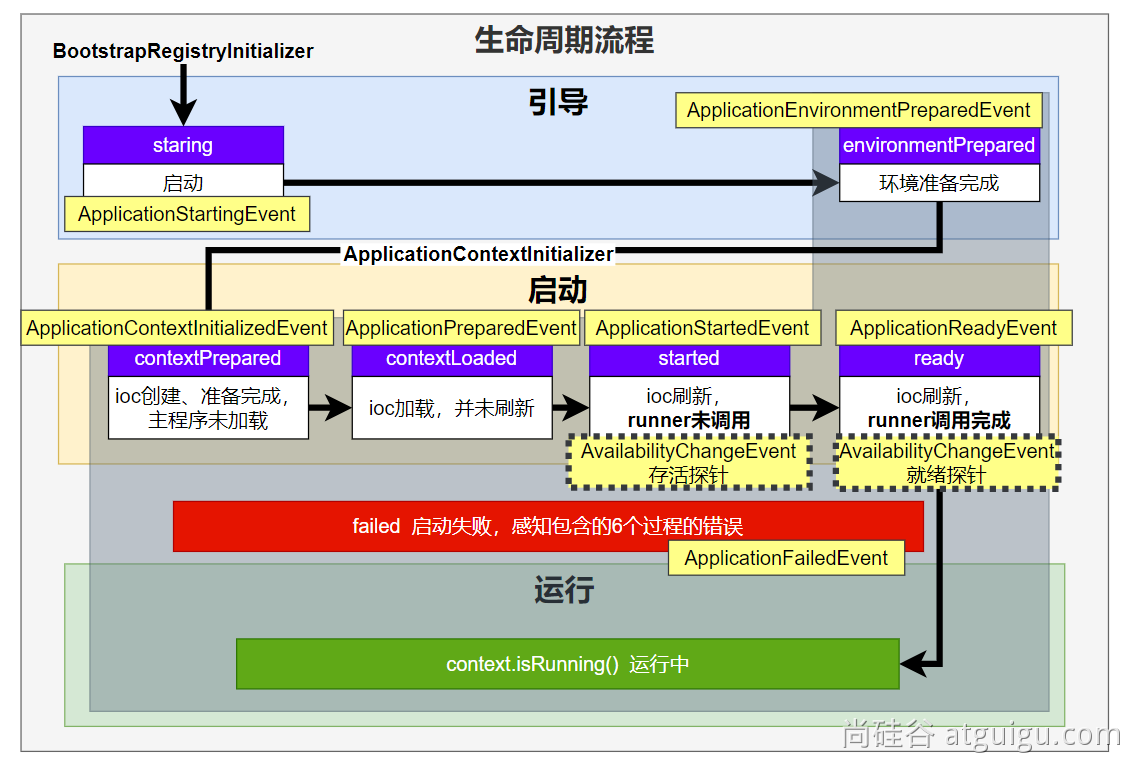
应用实践发送顺序如下
感知应用是否存活了:可能是植物状态,虽然活着但是不能处理请求。
应用是否就绪了:能响应请求,说明确实活的比较好
SpringBoot事件驱动开发
应用启动过程生命周期事件感知(9大事件)、应用运行中事件感知(无数种)。
- 事件发布:
ApplicationEventPublisherAware或者注入ApplicationEventMulticaster - 事件监听:
组件 + @EventListener
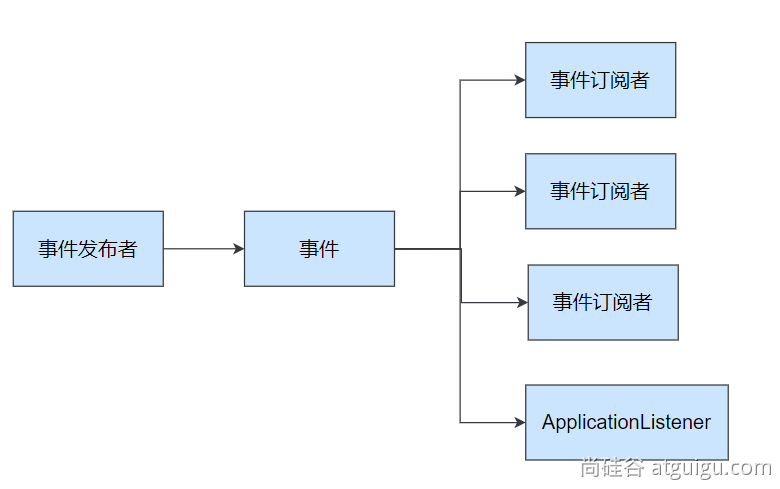
事件发布者
1 |
|
事件订阅者
也可以实现ApplicationListener接口监听事件
1 |
|
自动配置原理
入门理解
应用关注的三大核心:场景、配置、组件
自动配置流程
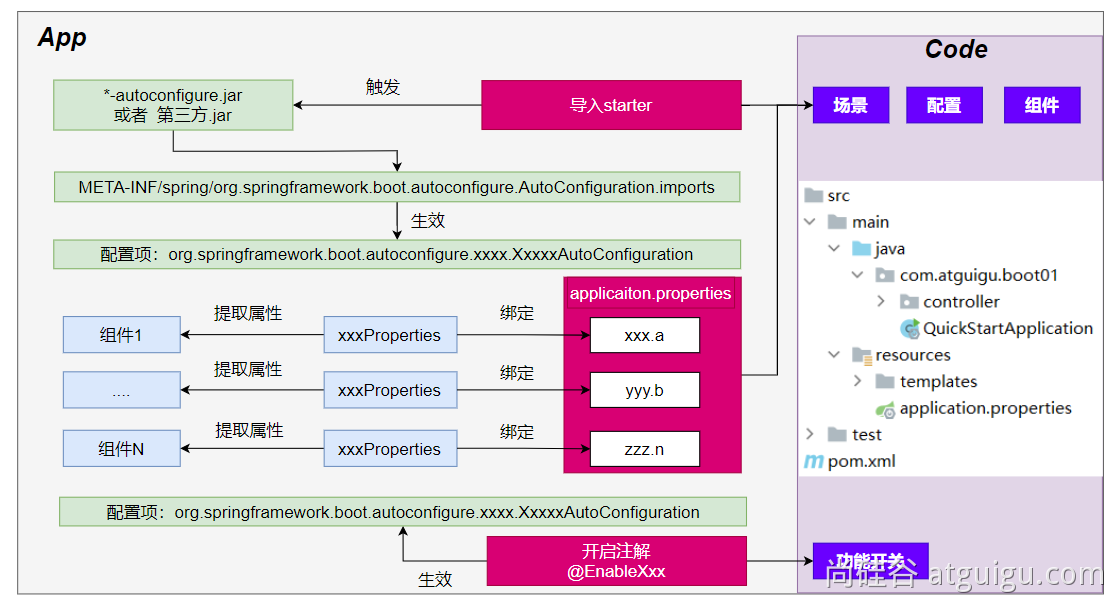
- 导入
starter - 依赖导入
autoconfigure - 寻找类路径下
META-INF\spring\org.springframework.boot.autoconfigure.AutoConfiguration.imports文件 - 启动,加载所有
自动配置类xxxAutoConfiguration- 给容器种配置功能(组件)
组件参数绑定到属性类种。xxxProperties属性类和配置文件前缀绑定@Conditional派生的条件注解进行判断组件是否生效
- 效果
- 修改配置文件,即可修改底层参数
- 所有场景自动配置好直接使用
- 可以注入SpringBoot配置好的组件随时使用
SPI机制
- Java中的SPI(Service Provider Interface)是一种软件设计模式,用于在应用程序中动态地发现和加载组件。****SPI的思想是,定义一个接口或抽象类,然后通过在classpath中定义实现该接口的类来实现对组件的动态发现和加载。
- SPI的主要目的是解决在应用程序中使用可插拔组件的问题。例如,一个应用程序可能需要使用不同的日志框架或数据库连接池,但是这些组件的选择可能取决于运行时的条件。通过使用SPI,应用程序可以在运行时发现并加载适当的组件,而无需在代码中硬编码这些组件的实现类。
- 在Java中,SPI的实现方式是通过在
META-INF/services目录下创建一个以服务接口全限定名为名字的文件,文件中包含实现该服务接口的类的全限定名。当应用程序启动时,Java的SPI机制会自动扫描classpath中的这些文件,并根据文件中指定的类名来加载实现类。 - 通过使用SPI,应用程序可以实现更灵活、可扩展的架构,同时也可以避免硬编码依赖关系和增加代码的可维护性。
在SpringBoot中,META-INF\spring\org.springframework.boot.autoconfigure.AutoConfiguration.imports
功能开关
- 自动配置:全都配置好,什么都不用管,自动批量导入
- 项目一启动,spi文件中指定的所有都加载
@EnableXxxx:手动控制哪些功能的开启,手动导入- 开启xxx功能
- 都是利用
@Import把此功能要用的组件导入进去
进阶理解
@SpringBootApplication
@SpringBootConfiguration
就是@Configuration,容器中的组件,配置类。spring ioc启动就会加载创建整个类对象
@EnableAutoConfiguration:开启自动配置
开启自动配置
@AutoConfigurationPackage:扫描主程序包,加载自己的组件
- 利用
@Import(AutoConfigurationPackages.Registrar.class)想要给容器中导入组件。 - 把主程序所在的包的所有组件导入进来(如果指定了包路径,使用指定的路径,如果没有指定,默认是主启动类所在路径)
@Import(AutoConfigurationImportSelector.class):加载所有自动配置类:加载starter导入的组件
1 | List<String> configurations = ImportCandidates.load(AutoConfiguration.class, getBeanClassLoader()).getCandidates(); |
扫描SPI文件:
META-INF\spring\org.springframework.boot.autoconfigure.AutoConfiguration.imports
@ComponentScan
组件扫描:排除一些组件(哪些不要)
排除前面已经扫描进来的配置类和自动配置类
1 |
完整启动加载流程
生命周期自动加载流程
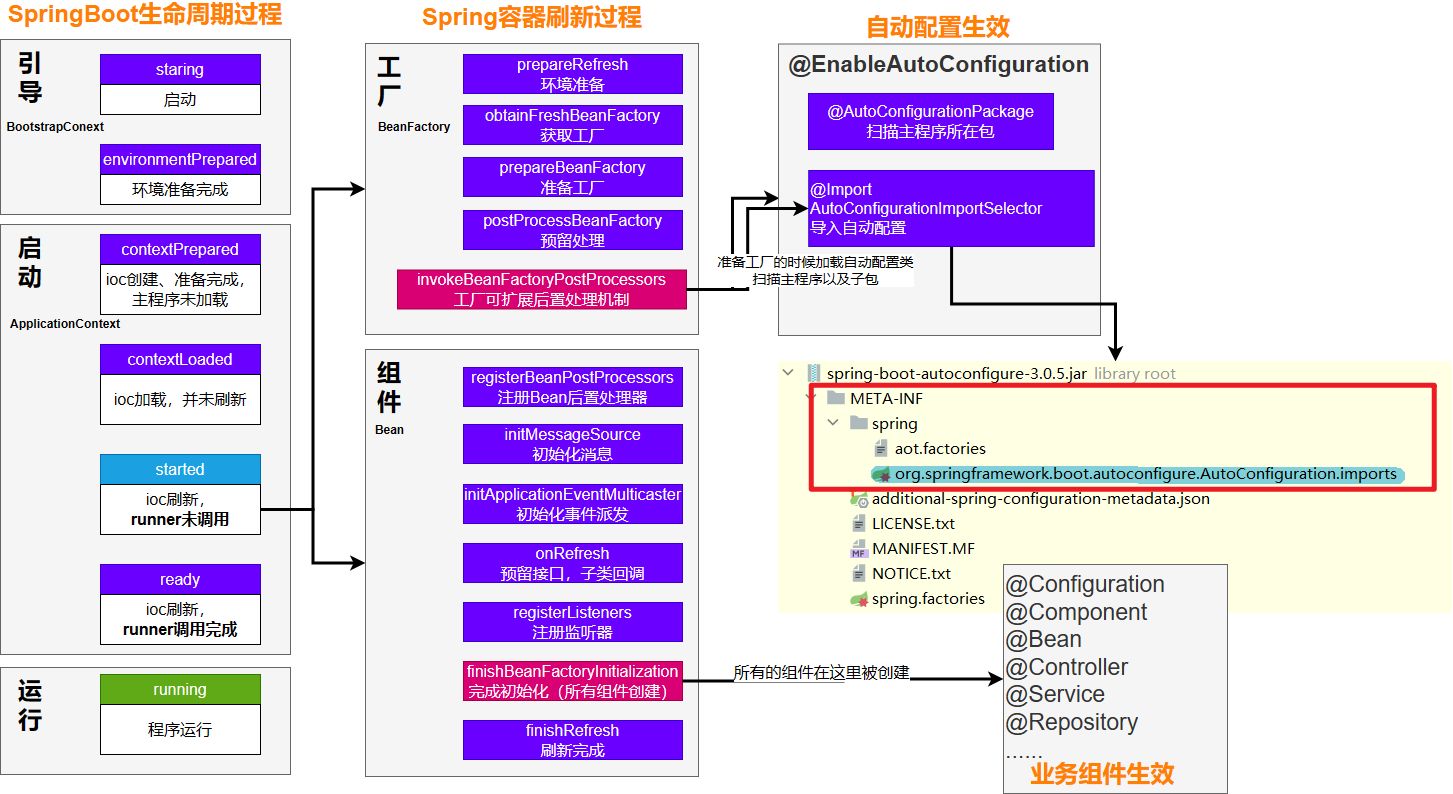
自定义starter
场景:抽取聊天机器人场景,它可以打招呼。
效果:任何项目导入此starter都具有打招呼功能,并且问候语中的人名需要可以在配置文件中修改
- 创建
自定义starter项目,引入spring-boot-starter基础依赖 - 编写模块功能,引入模块所有需要的依赖
- 编写
xxxAutoConfiguration自动配置类,帮其他项目导入整个模块需要的所有组件 - 编写配置文件
META-INF\spring\org.springframework.boot.autoconfigure.AutoConfiguration.imports指定启动需要加载的自动配置 - 其他项目引入即可使用
业务代码
自定义配置有提示,导入以下依赖重启项目,再写配置文件就有提示了
1 | <!-- 导入配置处理器,配置文件自定义的properties配置都会有提示--> |
1 | //此属性类和配置文件指定前缀绑定 |
基本抽取
- 创建starter项目,把公共代码需要的所有依赖导入
- 把公共代码复制进来
- 自己写一个
RobotAutoConfiguration,给容器中导入这个场景需要的所有组件- 为什么这些组件默认不会扫描进去?
- starter所在的包和引入它的项目的主程序所在的包不是父子层级
- 别人引入这个
starter,直接导入这个RobotAutoConfiguration,就能把这个场景的组件导入进来 - 功能生效
- 测试编写配置文件
使用@EnableXxx机制
1 |
|
别人引入starter只需要使用@EnableRobot注解即可开启功能
完全自动配置
- 依赖SpringBoot的SPI机制
META-INF\spring\org.springframework.boot.autoconfigure.AutoConfiguration.imports文件中编写好我们自动配置类的全类名即可- 项目启动,自动加载我们的自动配置类。